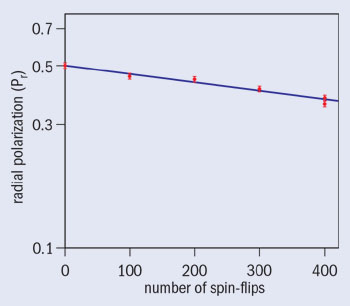As the venerable Cooler Ring at the Indiana University Cyclotron Facility in the US enters its final year, a Michigan-led team headed by Alan Krisch has notched up a polarized-beam milestone using the ring’s unique accelerator-physics capabilities. The team, which includes physicists from Michigan and Indiana in the US, IHEP-Protvino in Russia and KEK in Japan, has charmed a string of magnets known as a Siberian snake to spin-flip stored protons some 400 times with very little polarization loss.
Siberian snakes were invented at Novosibirsk in the late 1970s. A Siberian snake is a chain of quadrupoles and solenoids that has the ability to overcome any other spin-changing device or random spin-changing effects in any storage ring.
To achieve this latest result, however, the spin-flip team used a small RF-dipole magnet to charm the snake into occasionally surrendering its dominance of all spin motion. This could be done because the RF-dipole used was even more closely matched to the spin motion’s frequency than the Siberian snake.

The RF dipole’s polarization loss is about 12% in 400 spin-flips, giving a spin-flip efficiency of more than 99.9%. This could allow many spin-flips of polarized proton or electron beams while they are stored for billions of turns, offering the promise of greatly reduced systematic errors in spin-asymmetry experiments. This capability could be important for scattering experiments in storage rings that already have Siberian snakes.
The same RF-dipole magnet could give a 99.9% spin-flip efficiency to the polarized protons accelerated at Brookhaven’s RHIC (p8) and perhaps one day at CERN’s LHC, DESY’s HERA, or Fermilab’s Tevatron. This is possible because an RF-dipole’s transverse magnetic field is essentially invariant under the Lorentz transformation from its stationary rest frame to any highly relativistic proton or electron rest frame, in which each spin in the beam seems to receive the magnetic field’s instructions.
The RF dipole was built by Michigan’s Spin Physics Center in the late 1980s to serve as an injection-kicker to the Cooler Ring. Recycled in 1999, the dipole was connected to a small RF voltage supply, which gave it a weak transverse RF magnetic field. This allowed some spin-flipping with the Siberian snake in the Cooler Ring, but efficiency was very low and most of the original polarization was lost after a few spin-flips.
The team then tried to improve the spin-flip efficiency by increasing the RF dipole’s strength. The first step in this direction was taken by student Boris Blinov, who devised a way to increase the strength of the RF dipole to around 220 gauss cm while increasing its turn-on time from microseconds to milliseconds. This removed the high-frequency transient fields that had previously destroyed the beam and led to a spin-flip efficiency of 99.63 ± 0.05%, measured in May 2001.
Then, in November and December 2001, the group used a much stronger voltage supply to increase the RF dipole’s strength to about 560 gauss cm. This adjustment led to a 99.93 ± 0.02% spin-flip efficiency in a stored beam of 120 MeV protons.
The spin-flip team will spend its final year at the Cooler Ring on other experiments, since 99.93% seems sufficient. Possible projects include trying to spin-flip polarized deuterons and studying third- and fourth-order snake depolarizing resonances. These are hard to find at low-energy storage rings, but may be all too easy to find in proton rings such as Brookhaven’s RHIC and DESY’s HERA.
Further reading
B B Blinov et al. 2002 Phys. Rev. Lett. 88 014801.








